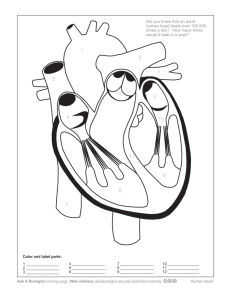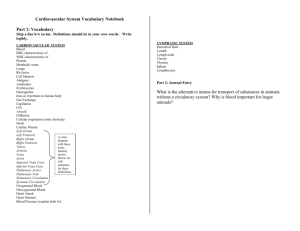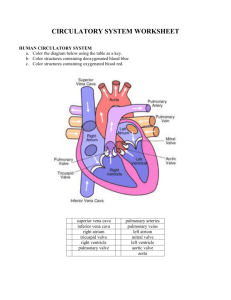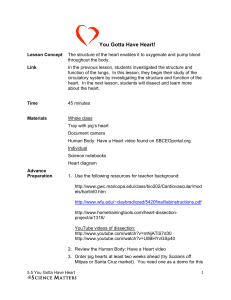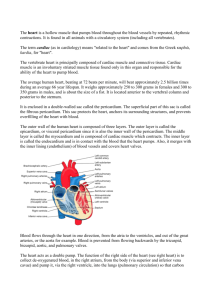PostBacc Anatomy Quiz Questions – THORAX
advertisement
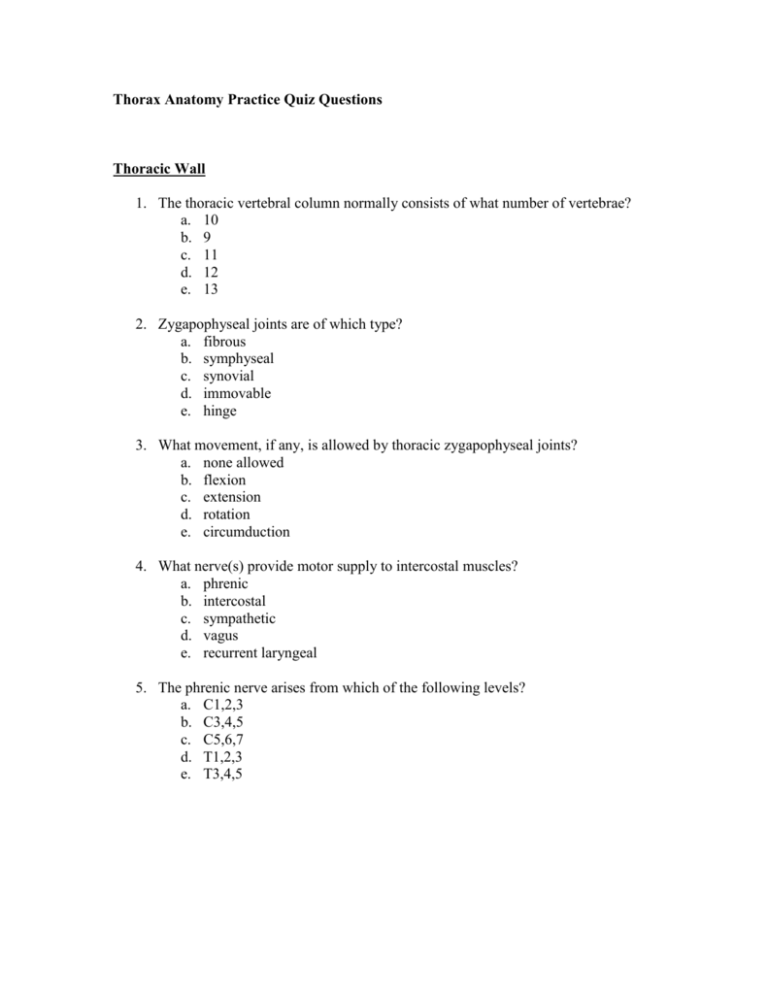
Thorax Anatomy Practice Quiz Questions Thoracic Wall 1. The thoracic vertebral column normally consists of what number of vertebrae? a. 10 b. 9 c. 11 d. 12 e. 13 2. Zygapophyseal joints are of which type? a. fibrous b. symphyseal c. synovial d. immovable e. hinge 3. What movement, if any, is allowed by thoracic zygapophyseal joints? a. none allowed b. flexion c. extension d. rotation e. circumduction 4. What nerve(s) provide motor supply to intercostal muscles? a. phrenic b. intercostal c. sympathetic d. vagus e. recurrent laryngeal 5. The phrenic nerve arises from which of the following levels? a. C1,2,3 b. C3,4,5 c. C5,6,7 d. T1,2,3 e. T3,4,5 6. The aorta traverses the diaphragm at what level? a. T6 b. T8 c. T10 d. T12 e. L2 Lungs/Pleura 7. Pleura lying against the ribs is termed? a. costal, parietal b. costal, visceral c. mediastinal, parietal d. mediastinal, visceral e. diaphragmatic, parietal 8. Which of the following descriptions of the normal pleural cavity are most correct? a. large air-filled space b. small air-filled space c. potential space filled with thin layer of fluid d. large space filled with large amount of fluid e. potential space with no fluid 9. Chylothorax indicates what type of fluid in the pleural cavity? a. water b. blood c. urine d. plasma e. lymph 10. What is the last layer pierced in a thoracocentesis? a. visceral pleura b. parietal pleura c. endothoracic fascia d. innermost intercostal muscle e. mediastinal pleura 11. Which of the following are true of pleural innervation? a. visceral pleura is pain insensitive b. parietal pleura is pain insensitive c. costal pleura is innervated by phrenic nerve d. diaphragmatic pleura is innervated by vagus nerve e. phrenic nerve innervates all pleura Mediastinum/Pericardium 12. Pericardiocentesis would pierce which layer last? a. fibrous pericardium b. serous, visceral pericardium c. serous, parietal pericardium d. epicardium e. endocardium 13. Which of the following is found in the middle mediastinum? a. thymus gland b. thoracic duct c. vagus n. d. sternopericardial ligament e. heart 14. The sternal angle is important because it…? a. marks level of rib 2 b. marks superior limit of pericardium c. marks begin/end of aortic arch d. marks level of tracheal bifurcation e. does all of the above Heart 15. The moderator band can be found in which heart chamber(s)? a. right atrium b. left atrium c. right ventricle d. left ventricle e. right and left ventricles 16. Which cardiac chamber(s) makes up the majority of the anatomical base of the heart? a. right atrium b. left atrium c. right ventricle d. left ventricle e. right ventricle and left atrium 17. Where is trabeculae carnae found in the heart? a. ventricles b. atria c. only left ventricle d. auricles e. only right atrium 18. What chamber makes up the right border of the heart? a. right ventricle b. left ventricle c. right atrium d. left atrium e. none 19. Where is the sinus venarum located? a. right ventricle b. left ventricle c. right atrium d. left atrium e. right auricle 20. Most of the venous blood from the heart tissue drains through…? a. great cardiac vein b. middle cardiac vein c. small cardiac vein d. coronary sinus e. anterior cardiac veins Superior Mediastinum 21. The ligamentum arteriosum connects what two structures? a. aortic arch/left pulmonary vein b. aortic arch/right pulmonary vein c. aortic arch/superior vena cava d. superior vena cava/inferior vena cava e. aortic arch/pulmonary artery 22. What two veins join to form the superior vena cava? a. inferior vena cava/azygos b. azygos/hemiazygos c. azygos/coronary sinus d. left and right brachiocephalic e. internal jugular/subclavian 23. An aneurysm in the aortic arch could most likely affect which nerve? a. right recurrent laryngeal b. right vagus c. right phrenic d. left recurrent laryngeal e. left phrenic 24. A stab would through the trachea could injure which structure lying behind? a. superior vena cava b. aortic arch c. thymus d. brachiocephalic vein e. esophagus Posterior Mediastinum/Lymphatics 25. The posterior mediastinum is directly posterior to what structure? a. endothoracic fascia b. sternum c. pericardium d. pleura e. diaphragm 26. The azygos vein drains into what major vessel? a. inferior vena cava b. superior vena cava c. aorta d. pulmonary artery e. pulmonary vein 27. Breasts drain mainly to what group of lymph nodes? a. axillary b. diaphragmatic c. intercostals d. tracheobronchial e. posterior mediastinal 28. Lungs drain initially through what group of lymph nodes? a. axillary b. diaphragmatic c. intercostals d. tracheobronchial e. posterior mediastinal Thoracic ANS 29. The GVE component of the autonomic system is basically a ________ neuron pathway. a. one b. two c. three d. four e. five 30. Sympathetics originate from what spinal cord region? a. T1-L2 b. T1-S1 c. T1-T10 d. T1-T5 e. T1-T12 31. Which of the following originate from T10-11 and innervate abdominal viscera? a. lesser splanchnic nerve b. least splanchnic nerve c. greater splanchnic nerve d. vagus nerve e. phrenic nerve 32. Which levels of the sympathetic chain contain white rami communicantes? a. all levels b. T1-T5 c. C2,3,4 d. S2,3,4 e. T1-L2 33. Cell bodies of general visceral afferents from thoracic viscera lie where? a. intermediolateral cell column b. dorsal root ganglion c. superior ganglion of vagus d. spinal cord e. sympathetic chain ganglia Answers: 1. 2. 3. 4. 5. D C D B B 6. D 7. A 8. C 9. E 10. B 11. A 12. C 13. E 14. E 15. C 16. B 17. A 18. C 19. C 20. D 21. E 22. D 23. D 24. E 25. C 26. B 27. A 28. D 29. B 30. A 31. A 32. E 33. B
